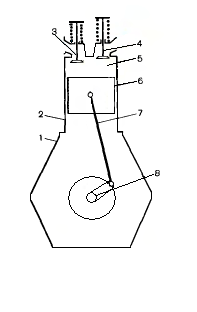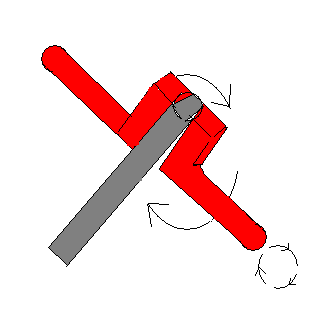Introduction
Internal combustion engines belong to the most widespread type of thermal engines, i.e. engines in which heat, released with the combustion of the fuel, is transformed into mechanical energy. The internal combustion engine is one of two main types of thermal engines, with external combustion engines being the second type of such engine. The history of the internal combustion engines is largely linked to the gradual developments in transportation, leading to that internal combustion engines can be sometimes called automotive engines, although such engines are used in airplanes, railroads, marine, and other, most industrial applications. With different types of fuels used, as well as different variations of components, designed for different tasks and purposes during different periods of the engine’s historical developments, the main principle of such engines remained the same, which is explained through the denomination of this type of engines.
In that regard, the purpose of this paper is in providing an overview of the main principles of the work of internal combustion engines, as well as their components and some of their variation. Additionally, the paper will briefly touch on the subject of the engines’ efficiency and one of the approaches toward its improvement.
Internal Combustion Engines
There are two types of engines, based on the number of the movements of the piston for an engine firing sequence. The two-cycle engine makes two-movement strokes, and accordingly, a four-stroke engine makes four. The latter is the type most commonly used and thus referring to the components of the engine, the four-stroke engine is implied, while the two-stroke engine will be briefly overviewed at the end of the following section.
The main components of the combustion engine (see Figure 1) include the following parts:

- Crankcase – a body that holds engine parts, where differences might be seen through the design and the type of material used (Glenn Research Center, 2008).
- Cylinder – a cylindrical container, in which the piston moves. The determinant aspects of the cylinder include stroke and bore, where the stroke is the distance the piston moves from the top to the bottom of the cylinder, while the bore is the internal diameter of the cylinder (Parker, 2003). Additionally, the arrangements and the number of cylinders can be used as an indication of the engine’s type and power, e.g. 4 or 8 cylinders, and v-shaped or w shaped cylinders.
- Intake valve – a valve through which a mixture of air and fuel enters the combustion chamber. The positions of the valve are either opened or closed (Glenn Research Center, 2008).
- Exhaust valve – a valve through which the exhaust exits the combustion chamber. The positions of the valve are either opened or closed.
- Combustion chamber – a part of the engine in which the mixture of fuel and air is ignited and burned. It can be a part of the cylinder (see figure 1), or as a separate chamber at the top of the cylinder.
- Piston – A moving component of the combustion engine, fitting in the cylinder. The main task of the piston is moving the crankshaft through the connecting rod. The stroke, defined earlier is denoted by two limits of the piston’s movement, top dead center (Tc), and top-bottom center (Bc), showing the top up and top-down position of the piston’s movement pattern.
- Rod – merely a connection between the piston and the crankshaft, through which the linear movement of the piston is transferred into an angular movement of the crankshaft.
- Crankshaft – see figure 2, a single “snake-shaped” piece of metal, which is connected to the rod, the angular movement of which is denoted as the crankshaft motion (Glenn Research).

The Work of the Engine
The four-stroke engine is denoted due to four strokes for a single firing sequence is performed, and as the stroke is the distance between the upper limit to the bottom limit of the piston’s movement, four-stroke imply the movement of the piston four times, i.e. from Tc to Bc and
Bc to Tc twice. Each movement can represent a specific process occurring within the internal combustion engine which can be summarized in the order of their appearance as follows:
- Intake stroke – The process starts with the movement of the piston from the Tc to Bc position, during which the intake valve opens and the mixture of fuel and air fills the combustion chamber and the free space in the cylinder at low pressure. Reaching Bc position the intake valve closes (Glenn Research Center, 2008).
- Compression stroke – The process starts with the movement of the piston from the Bc position, where the volume is reduced, with both valves closed, and due to the reduction of the volume the pressure increases with the piston reaching Tc position.
- Power stroke – This process starts with the piston at the Tc position, where the volume is the smallest and the pressure is the highest. At this point opening of electrical contact in the combustion chamber ignites the mixture, which releases heat and exhaust gases in the chamber. The heat increases the pressure in the chamber, which pushes the piston toward the Bc position initiating the power stroke. During the power stroke, the force on the piston is transferred through the rod to the crankshaft into an angular motion. Reaching the Bc position the volume is gradually increasing, while pressure decreases.
- Exhaust stroke – The process starts with the piston at the Bc position, at which point the exhaust valve opens. During the movement from Bc to Tc, the cylinder and the chamber are cleared from any remaining exhaust gases, where the piston pushes the exhaust during the movement toward the exhaust valve. The exhaust valve closes with the piston reaching Tc ending a single firing sequence (Glenn Research Center, 2008).
In a two-stroke engine, the difference is that there are no moving valves, and the spark ignites each time the piston reaches the Tc position. The new mixture is drawn to the chamber at the same time while the piston is going to Bc from combustion (Parker, 2003).
Efficiency
An important notion in internal combustion engine efficiency is such a factor as the compression ratio. The compression ratio can be defined as the volume of the combustion chamber at Tc, compared to Bc.
This ratio was increasing through the historical period of the engines’ development, where the period of 1920-1940 has a compression ratio of 4 to 5, while modern engines, car engines specifically, have a ratio within the range of 8 – 11 (Parker, 2003).
Another important notion in measuring and increasing the efficiency of internal combustion engines is the engine’s maximum work extractable from its resource, i.e. the fuel, which is called exergy (Teh et al., 2008). In that regard, it can be stated that mostly the efficiency of the engine can be denoted by the management of exergy losses that inevitably occur. In The, Miller, and Edwards (2008), the authors analyzed the exergy destruction during the combustion process stating that two important determinants for minimizing exergy destruction can be seen through the characteristics of the reactant, i.e. the fuel, and its thermodynamic states at the start and at the end of the combustion, where the internal energy at the point of combustion is a strong function of exergy destruction, and the separation of the processes in the engine operation cycle, where the associated exergy of each of the processes, i.e. the preparation of the reactant, the combustion, and the work, should be analyzed independently in order to maximize the efficiency of the engine.
Conclusion
It can be seen that despite the constant developments of engines, the changes in the design and the increase of their efficiency, the main principles of thermodynamics implemented through the work of internal combustion engines are the same. This paper overviewed the most common component of the four-stroke combustion engine, which despite the possibility of slight variations, the analyzed components are mostly the same in most internal combustion engines. The paper also analyzed the work principles of the internal combustion engines, showing the phases of the four-stroke engine specifically, being the most commonly used. In that regard, it should be stated that even in engines with other configurations these main phases will occur, although with different variations mostly related to the number of strokes in a single sequence. Finally, the paper briefly overviewed the determinants of the engines’ efficiency, from which it can be seen that there is still a range for improvements, to maximize the output of the engines.
References
GLENN RESEARCH CENTER. 2008. 4-Stroke Internal Combustion Engine. Web.
PARKER, B. R. 2003. The Isaac Newton school of driving : physics and your car, Baltimore, MD, Johns Hopkins University Press.
TEH, K., MILLER, S. & EDWARDS, C. 2008. Thermodynamic requirements for maximum internal combustion engine cycle efficiency. Part 1: optimal combustion strategy. International Journal of Engine Research, 9. Web.